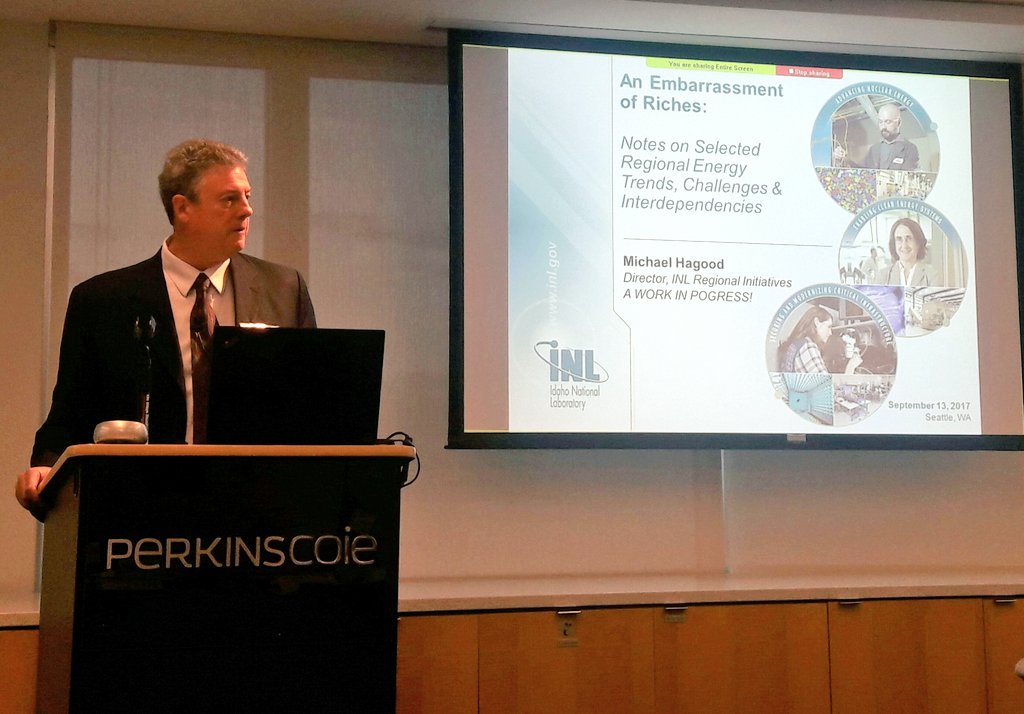The northwest region is undergoing a transition in its energy needs as growing urban centers put more demands on resources, and the U.S. moves towards cleaner energy and greater electrification. While urban centers such as Seattle are often the focus of conversations about how to innovate for and adapt to a new energy future, the resources that will fuel that new future are largely found in the interior west. In the midst of those natural resources is the U.S. Department of Energy’s Idaho National Laboratory (INL) – a research and development institution working to improve grid and battery technologies, develop viable nuclear energy, strengthen cybersecurity and more.
 |
|
| Michael Hagood speaks about regional energy collaboration at first CleanTech breakfast of the season |
Michael Hagood, INL Director of Regional Initiatives, kicked off this year’s CleanTech Alliance Breakfast Series with a talk focused on the regional collaboration needed to better leverage the northwest’s abundance of resources for future energy needs on a local, national and international scale.
“As we move further into the 21st century, we need to ask – how can we better utilize these resources in an integrated, more holistic fashion?” Hagood said at the September 13 breakfast sponsored by Perkins Coie.
Hagood’s talk outlined the region’s energy trends, as well as challenges and opportunities that have created a “window of time” for greater collaboration. Here is an overview of the key trends:
Six Regional Energy Trends
- Natural gas is a strong new contender in the energy market due to significant technology and policy development in the past 10 years.
- Renewable energy sources are becoming more cost-effective due to continued improvements in these technologies, and stronger state focus on transitioning fully to renewables in the next 20 years. Wind is particularly viable in the northwest.
- Improving energy efficiency is preferred first choice to meet demand, and all utilities in the region are prioritizing implementing these practices.
- Use of coal-fired electricity – which currently accounts for much of the region’s energy – is undergoing significant reductions. Cost effectiveness of natural gas, penetration of renewable energy into the market and low growth in demand for coal have contributed to this change. Hagood referred to a recent DOE Grid Study which provides more details on anticipated reductions and coal plant retirements.
- Growing populations put greater strain on food, energy and water sources Urban centers need more of these resources. As these sources largely come from east of the Cascades, increase in demand requires development and upkeep of critical energy infrastructure.
- Geopolitical trends also increase dependency on northwest resources Asia in particular is increasing demand for these resources as the continent undergoes its own population growth.
These trends lead to many challenges and opportunities for the region – from finding ways to implement new sources of energy effectively, to finding new jobs for people in outgoing industries, to the need for greater cybersecurity. Given the resources, expertise and interdependencies spanning the region – which Hagood identified as Washington, Oregon, Idaho, Wyoming, Montana, Utah, Alberta and British Columbia – he would like to see more collaboration to build proactive plans for leveraging opportunities and taking on challenges.
To foster that collaboration, Hagood is leading efforts with the CleanTech Alliance and other northwest institutions to develop a Northwest Energy Innovation Alliance. The group will evaluate the challenges and opportunities to develop solutions for the region, and innovations that can have a global impact. Examples of regional R&D partnerships include:
- “Battery 500,” a DOE program designed to accelerate R&D of lithium batteries for electric vehicles. The program is led by Pacific Northwest National Laboratory in partnership with INL and University of Washington.
- Small modular nuclear reactor R&D; TerraPower, NuScale Power, Oregon State University and INL are working on fuel performance and fuel fabrication approaches.
- Joint DOE-India R&D project to help advance development of the power grid. The project is led by Washington State University in partnership with INL, Avista, Snohomish PUD and others.
- Partnership between PNNL and INL on a national initiative to provide cyber-physical innovation capabilities for control systems.
In addition, the Northwest Energy Innovation Alliance will work on developing job opportunities in this new energy future. One example of that work is the Washington Jobs Project Report completed by the University of Washington Clean Energy Institute and Western Washington University Institute for Energy Studies to offer policy recommendations that will foster job growth in Washington’s grid modernization industry. Partners include research institutions, national labs, companies and local governments.
About INL
INL is the lead nuclear energy lab for the nation. Researchers on advancing innovation and nuclear energy – specifically nuclear reactors and Small Modular Reactors. The lab’s expertise also includes energy and national security research. Located in CITY, the lab has over 4,000 employees and covers 890 square miles of Idaho. Learn more by visiting https://www.inl.gov/ and following on Twitter at @INL.
Next breakfast – October 11
Make sure to reserve your seat at the next breakfast, or buy a series pass. The series is also available through webcast – and we love seeing Twitter activity from our Eastern Washington members. Follow the #CleanTechBacon Twitter conversation or watch the full breakfast session recorded video below.